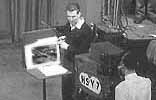|
Saturdays
|
| Saturday was a big day at the station,
not only was there the football broadcast, the studio's were hard at work. |
| At around 11 am a whole gang of talented
kids would arrive for the "Brian and the Juniors" show hosted by a young
Brian Naylor, who was actually on 3DB radio station staff and had not yet
moved to channel 7. The show was the forerunner to Johnny Young's "Young
Talent Time" and ran for many years. When I first started the show went
to air live, later it was taped and became national. Many stars owe their
start to the show. people like:- Jamie Redfern, Anne Watt, Peter Doyle,
Rod Kirkham, Phillip Gould, Debra Byrne , Jan Scali, Debra Byrne &
Vikki Broughton. The show was produced by Mac Irvine who owned an Advertising
agency who had the Swallow & Aerial Biscuit company account, who naturally
sponsored the show. The earlier live shows were done in Studio 2 at Dorcas
street, with the 2 remaining camera from the 3 that had gone to the football.
I was audio engineer on the show for a number of years. |
|
 |
 |
|
Brian Naylor
|
Peter Doyle
|
 |
 |
|
Rod Kirkham
|
Jamie Redfern
|
|
Zig
& Zag
|
| Meanwhile in camera less Studio 1
the sets were being set and rehearsals attempted for Peters Fun Fair featuring
Zig (Jack Perry) and Zag (Doug Makenzie) |
|
|
| The show went to air straight after
Brian and the Juniors at 5.30 pm. That gave them 2 minutes of commercials
to drag the camera's through to Studio 1. The Zig and Zag show was pure
slapstick, they made the story us as they went along, only stopping at
regular intervals to do their own commercials for Peters Ice cream. Then
straight back into the story, if there was one, no problem, just throw
some cream |
| pies at each other and at the
ever suffering Uncle Roy and no body could remember if there was a story
anyway. |

|
|
Jack Perry played Zig
|
|
| Straight after Zig & Zag, it
was time for the news, back in the now reset studio 2, As before the 2
camera's were dragged back from Studio 1 to Studio 2 during the station
break. News in those days relied heavily on film footage, either shot by
seven's cameramen, or syndicated film rushed from the airport. Most interstate
stories were a day or so late as the cable had not yet been put through
to Sydney. |
|
| International stories could be up
to a week old. Stories were often just illustrated by photos send down
from the stations owners, The Herald and Weekly Times. These were mounted
on a Flip-stand and the camera pointed at it. A good flipper could flip
the card forward so fast that you would believe you were seeing a cut to
another camera. |

|
|
Flip card operator Ken Fitzgerald
|
| We couldn't even put reporters phone
calls on air. These were the days before Talkback Radio and the Postmaster
generals department (PMG) strictly forbad the broadcasting or recording
of phone calls. Sometime we did voice interviews on location with a spring
wound, battery valve tape recorder, then play overlay film shots showing
the interviewee in wide shot only. |
|
|

